Remote Measurements of Industrial CO2 Emissions Using a Ground-Based Differential Absorption Lidar in the 2 µm Wavelength Region
Abstract
1. Introduction
2. Materials and Methods
2.1. DIAL System
2.2. Wavelength Selection
2.3. Laser Source
2.4. Detection System
2.5. Calculated Emissions from Test Site
2.6. In-Stack Measurements Methodology
3. Results
3.1. Derivation of the Differential Absorption Coefficient
3.2. DIAL Measurements
3.3. In-Stack Measurements
3.4. Calculated Emissions
3.5. Comparison of Results
4. Discussion
Author Contributions
Funding
Data Availability Statement
Acknowledgments
Conflicts of Interest
References
- Intergovernmental Panel on Climate Change. Climate Change 2021–The Physical Science Basis: Working Group I Contribution to the Sixth Assessment Report of the Intergovernmental Panel on Climate Change, 1st ed.; Cambridge University Press: Cambridge, UK, 2023. [Google Scholar] [CrossRef]
- 32018R2066; Commission Implementing Regulation (EU) 2018/2066 on the Monitoring and Reporting of Greenhouse Gas Emissions Pursuant to Directive 2003/87/EC of the European Parliament and of the Council and Amending Commission Regulation (EU) No 601/2012. European Commission: Brussels, Belgium, 2018.
- Timonen, K.; Sinkko, T.; Luostarinen, S.; Tampio, E.; Joensuu, K. LCA of anaerobic digestion: Emission allocation for energy and digestate. J. Clean. Prod. 2019, 235, 1567–1579. [Google Scholar] [CrossRef]
- Gardner, N.; Manley, B.J.W.; Pearson, J.M. Gas emissions from landfills and their contributions to global warming. Appl. Energy 1993, 44, 165–174. [Google Scholar] [CrossRef]
- Gueddari-Aourir, A.; García-Alaminos, A.; García-Yuste, S.; Alonso-Moreno, C.; Canales-Vázquez, J.; Zafrilla, J.E. The carbon footprint balance of a real-case wine fermentation CO2 capture and utilization strategy. Renew. Sustain. Energy Rev. 2022, 157, 112058. [Google Scholar] [CrossRef]
- UK Government. Net Zero Strategy: Build Back Greener; UK Government: London, UK, 2021.
- McGonigle, A.J.S. Volcano remote sensing with ground-based spectroscopy. Phil. Trans. R. Soc. A Math. Phys. Eng. Sci. 2005, 363, 2915–2929. [Google Scholar] [CrossRef][Green Version]
- Bailey, D.M.; Adkins, E.M.; Miller, J.H. An open-path tunable diode laser absorption spectrometer for detection of carbon dioxide at the Bonanza Creek Long-Term Ecological Research Site near Fairbanks, Alaska. Appl. Phys. B 2017, 123, 245. [Google Scholar] [CrossRef]
- Xin, F.; Li, J.; Guo, J.; Yang, D.; Wang, Y.; Tang, Q.; Liu, Z. Measurement of Atmospheric CO2 Column Concentrations Based on Open-Path TDLAS. Sensors 2021, 21, 1722. [Google Scholar] [CrossRef]
- Lan, L.; Ghasemifard, H.; Yuan, Y.; Hachinger, S.; Zhao, X.; Bhattacharjee, S.; Bi, X.; Bai, Y.; Menzel, A.; Chen, J. Assessment of Urban CO2 Measurement and Source Attribution in Munich Based on TDLAS-WMS and Trajectory Analysis. Atmosphere 2020, 11, 58. [Google Scholar] [CrossRef]
- Nwaboh, J.A.; Werhahn, O.; Ortwein, P.; Schiel, D.; Ebert, V. Laser-spectrometric gas analysis: CO2–TDLAS at 2 µm. Meas. Sci. Technol. 2013, 24, 015202. [Google Scholar] [CrossRef]
- Hrad, M.; Huber-Humer, M.; Reinelt, T.; Spangl, B.; Flandorfer, C.; Innocenti, F.; Yngvesson, J.; Fredenslund, A.; Scheutz, C. Determination of methane emissions from biogas plants, using different quantification methods. Agric. For. Meteorol. 2022, 326, 109179. [Google Scholar] [CrossRef]
- Crisp, D. NASA Orbiting Carbon Observatory: Measuring the column averaged carbon dioxide mole fraction from space. J. Appl. Remote Sens. 2008, 2, 023508. [Google Scholar] [CrossRef]
- Hakkarainen, J.; Ialongo, I.; Tamminen, J. Direct space-based observations of anthropogenic CO2 emission areas from OCO-2. Geophys. Res. Lett. 2016, 43, 11400–11406. [Google Scholar] [CrossRef]
- Suto, H.; Kataoka, F.; Kikuchi, N.; Knuteson, R.O.; Butz, A.; Haun, M.; Buijs, H.; Shiomi, K.; Imai, H.; Kuze, A. Thermal and near-infrared sensor for carbon observation Fourier transform spectrometer-2 (TANSO-FTS-2) on the Greenhouse gases Observing SATellite-2 (GOSAT-2) during its first year in orbit. Atmos. Meas. Tech. 2021, 14, 2013–2039. [Google Scholar] [CrossRef]
- Pultarova, T. New Satellite to Police Carbon Dioxide Emitters from Space. Available online: https://www.space.com/ghgsat-carbon-dioxide-detecting-satellite-to-launch (accessed on 8 February 2023).
- Robinson, R.; Gardiner, T.; Innocenti, F.; Woods, P.; Coleman, M. Infrared differential absorption Lidar (DIAL) measurements of hydrocarbon emissions. J. Environ. Monit. 2011, 13, 2213–2220. [Google Scholar] [CrossRef] [PubMed]
- Innocenti, F.; Robinson, R.A.; Gardiner, T.D.; Tompkins, J.; Smith, S.; Lowry, D.; Fisher, R. Measurements of Methane Emissions and Surface Methane Oxidation at Landfills, WR1125; Report prepared for Defra by NPL; Defra: London, UK, 2013; p. 89.
- Innocenti, F.; Robinson, R.; Gardiner, T.; Howes, N.; Yarrow, N. Comparative Assessment of Methane Emissions from Onshore LNG Facilities Measured Using Differential Absorption Lidar. Environ. Sci. Technol. 2023, 57, 3301–3310. [Google Scholar] [CrossRef] [PubMed]
- CEN EN 17628; Fugitive and Diffuse Emissions of Common Concern to Industry Sectors Standard Method to Determine Diffuse Emissions of Volatile Organic Compounds into the Atmosphere. 2022. Available online: https://standards.cencenelec.eu/dyn/www/f?p=205:110:0::::FSP_PROJECT,FSP_LANG_ID:67021,25&cs=1499A1C530EC17BFF9D3EB0305EFECA18 (accessed on 2 August 2023).
- Robinson, R.A.; Gardiner, T.D.; Innocenti, F.; Finlayson, A.; Woods, P.T.; Few, J.F.M. First measurements of a carbon dioxide plume from an industrial source using a ground based mobile differential absorption lidar. Environ. Sci. Process. Impacts 2014, 16, 1957–1966. [Google Scholar] [CrossRef]
- Stroud, J.R.; Dienstfrey, W.J.; Plusquellic, D.F. Study on Local Power Plant Emissions Using Multi-Frequency Differential Absorption LIDAR and Real-Time Plume Tracking. Remote Sens. 2023, 15, 4283. [Google Scholar] [CrossRef]
- Yue, B.; Yu, S.; Li, M.; Wei, T.; Yuan, J.; Zhang, Z.; Dong, J.; Jiang, Y.; Yang, Y.; Gao, Z.; et al. Local-Scale Horizontal CO2 Flux Estimation Incorporating Differential Absorption Lidar and Coherent Doppler Wind Lidar. Remote Sens. 2022, 14, 5150. [Google Scholar] [CrossRef]
- Ismail, S.; Koch, G.; Abedin, N.; Refaat, T.; Rubio, M.; Singh, U. Development of Laser, Detector, and Receiver Systems for an Atmospheric CO2 Lidar Profiling System. In Proceedings of the 2008 IEEE Aerospace Conference, Big Sky, MT, USA, 1–8 March 2008; pp. 1–7. [Google Scholar]
- Refaat, T.F.; Ismail, S.; Koch, G.J.; Rubio, M.; Mack, T.L.; Notari, A.; Collins, J.E.; Lewis, J.; De Young, R.; Choi, Y.; et al. Backscatter 2-μm Lidar Validation for Atmospheric CO2 Differential Absorption Lidar Applications. IEEE Trans. Geosci. Remote Sens. 2011, 49, 572–580. [Google Scholar] [CrossRef]
- Singh, U.N.; Refaat, T.F.; Petros, M. Triple-pulse integrated path differential absorption lidar for carbon dioxide measurement—Novel lidar technologies and techniques with path to space. In Proceedings of the 2017 IEEE International Geoscience and Remote Sensing Symposium (IGARSS), Fort Worth, TX, USA, 23–28 July 2017; pp. 4212–4215. [Google Scholar]
- Gibert, F.; Flamant, P.H.; Cuesta, J.; Bruneau, D. Vertical 2-μm Heterodyne Differential Absorption Lidar Measurements of Mean CO2 Mixing Ratio in the Troposphere. J. Atmos. Ocean. Technol. 2008, 25, 1477–1497. [Google Scholar] [CrossRef]
- Gibert, F.; Edouart, D.; Cénac, C.; Pellegrino, J.; Le Mounier, F.; Dumas, A. 2-μm Coherent DIAL for CO2, H2O and Wind Field Profiling in the Lower Atmosphere: Instrumentation and Results. EPJ Web Conf. 2016, 119, 03005. [Google Scholar] [CrossRef]
- Bohren, C.F.; Huffman, D.R. Absorption and Scattering of Light by Small Particles; Wiley-VCH: Weinheim, Germany, 2004; ISBN 978-0-471-29340-8. [Google Scholar]
- Measures, R.M. Laser Remote Sensing: Fundamentals and Applications; Wiley: New York, NY, USA, 1984; ISBN 978-0-471-08193-7. [Google Scholar]
- Innocenti, F.; Gardiner, T.; Robinson, R. Uncertainty Assessment of Differential Absorption Lidar Measurements of Industrial Emissions Concentrations. Remote Sens. 2022, 14, 4291. [Google Scholar] [CrossRef]
- Gardiner, T.; Helmore, J.; Innocenti, F.; Robinson, R. Field Validation of Remote Sensing Methane Emission Measurements. Remote Sens. 2017, 9, 956. [Google Scholar] [CrossRef]
- HITRAN on the Web. Available online: https://hitran.iao.ru/ (accessed on 8 August 2022).
- CEN/TS 17405:2020; Stationary Source Emissions-Determination of the Volume Concentration of Carbon Dioxide-Reference Method: Infrared Spectrometry. Available online: https://standards.cencenelec.eu/dyn/www/f?p=CEN:110:0::::FSP_PROJECT,FSP_ORG_ID:66891,6245&cs=1DEC7E3239BF18057FA7D1E7B51D5CDAF (accessed on 2 August 2023).
- EN 15259:2007; Air Quality-Measurement of Stationary Source Emissions-Requirements for Measurement Sections and Sites and for the Measurement Objective, Plan and Report. 2007. Available online: https://standards.cencenelec.eu/dyn/www/f?p=CEN:110:0::::FSP_PROJECT,FSP_ORG_ID:22623,6245&cs=1ED53AEC54D26A0BC2E5A772A04F4BCDB (accessed on 2 August 2023).
- CEN/TR 17078:2017; Stationary Source Emissions-Guidance on the Application of EN ISO 16911-1. 2017. Available online: https://standards.cencenelec.eu/dyn/www/f?p=CEN:110:0::::FSP_PROJECT,FSP_ORG_ID:62770,6245&cs=160F34108A1ECA2689CAEA5977FCC0502 (accessed on 2 August 2023).
- EN 14789:2017; Stationary Source Emissions—Determination of Volume Concentration of Oxygen—Standard Reference Method: Paramagnetism. 2017. Available online: https://www.en-standard.eu/csn-en-14789-stationary-source-emissions-determination-of-volume-concentration-of-oxygen-standard-reference-method-paramagnetism/ (accessed on 2 August 2023).
- EN 15058:2017; Stationary Source Emissions-Determination of the Mass Concentration of Carbon Monoxide-Standard Reference Method: Non-Dispersive Infrared Spectrometry. 2017. Available online: https://standards.cencenelec.eu/dyn/www/f?p=CEN:110:0::::FSP_PROJECT,FSP_ORG_ID:39063,6245&cs=15C8FC63EC8538A17755FCE8DD923D00E (accessed on 2 August 2023).
- EN 14790:2017; Stationary Source Emissions-Determination of the Water Vapour in Ducts-Standard Reference Method. 2017. Available online: https://standards.cencenelec.eu/dyn/www/f?p=CEN:110:0::::FSP_PROJECT,FSP_ORG_ID:39062,6245&cs=1AD65D866611A52E23DA09770A16F2315 (accessed on 2 August 2023).
- Therneau, T. Deming: Deming, Thiel-Sen and Passing-Bablock Regression. R Package Version 1.0-1 2014. Available online: https://cran.r-project.org/web/packages/deming/vignettes/deming.pdf (accessed on 30 July 2023).
- Deming, W.E. Statistical Adjustment of Data; Unabridged and Corr. Republication; Dover Publications: New York, NY, USA, 1964. [Google Scholar]
- Fasano, G.; Vio, R. Fitting a Straight Line with Errors on both Coordinates. Bull. D’information Du Cent. De Donnees Stellaires 1988, 35, 191. [Google Scholar]
- EN 15267-3:2007; Air Quality-Certification of Automated Measuring Systems-Part 3: Performance Criteria and Test Procedures for Automated Measuring Systems for Monitoring Emissions from Stationary Sources. 2007. Available online: https://standards.cencenelec.eu/dyn/www/f?p=CEN:110:0::::FSP_PROJECT,FSP_ORG_ID:22226,6245&cs=17DC65A9B48218CF7878CAF72B4F06830 (accessed on 15 September 2023).

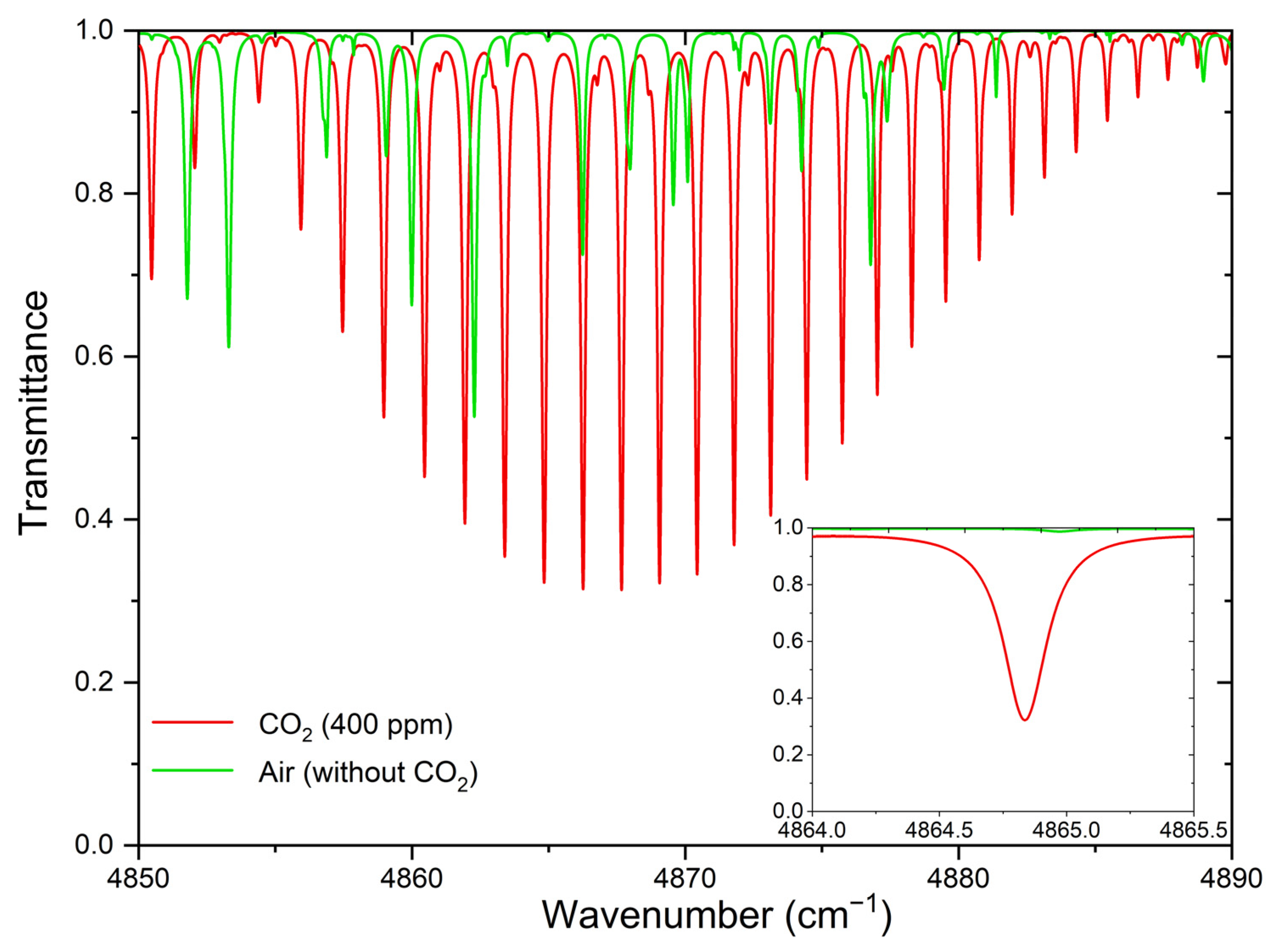
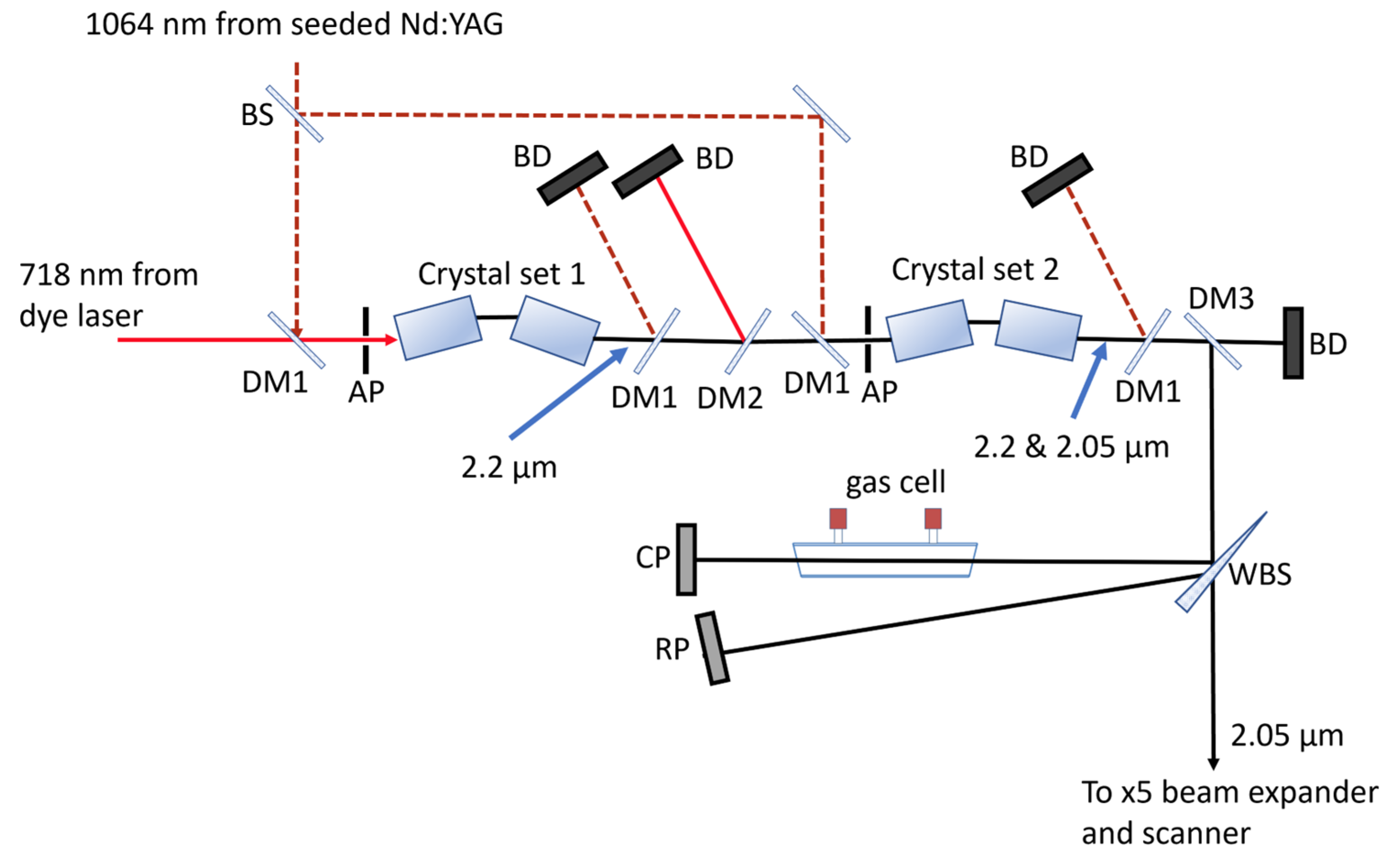

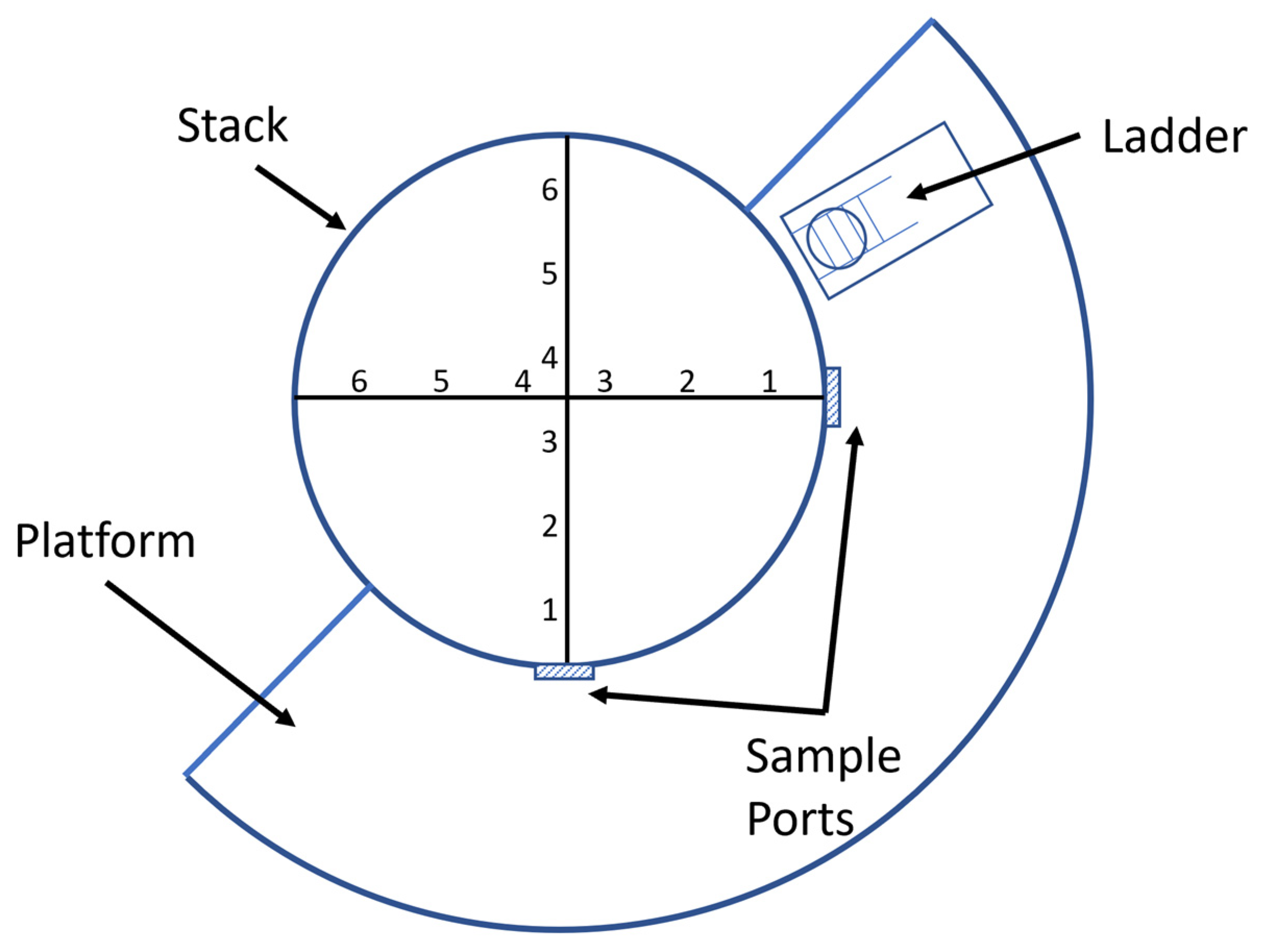


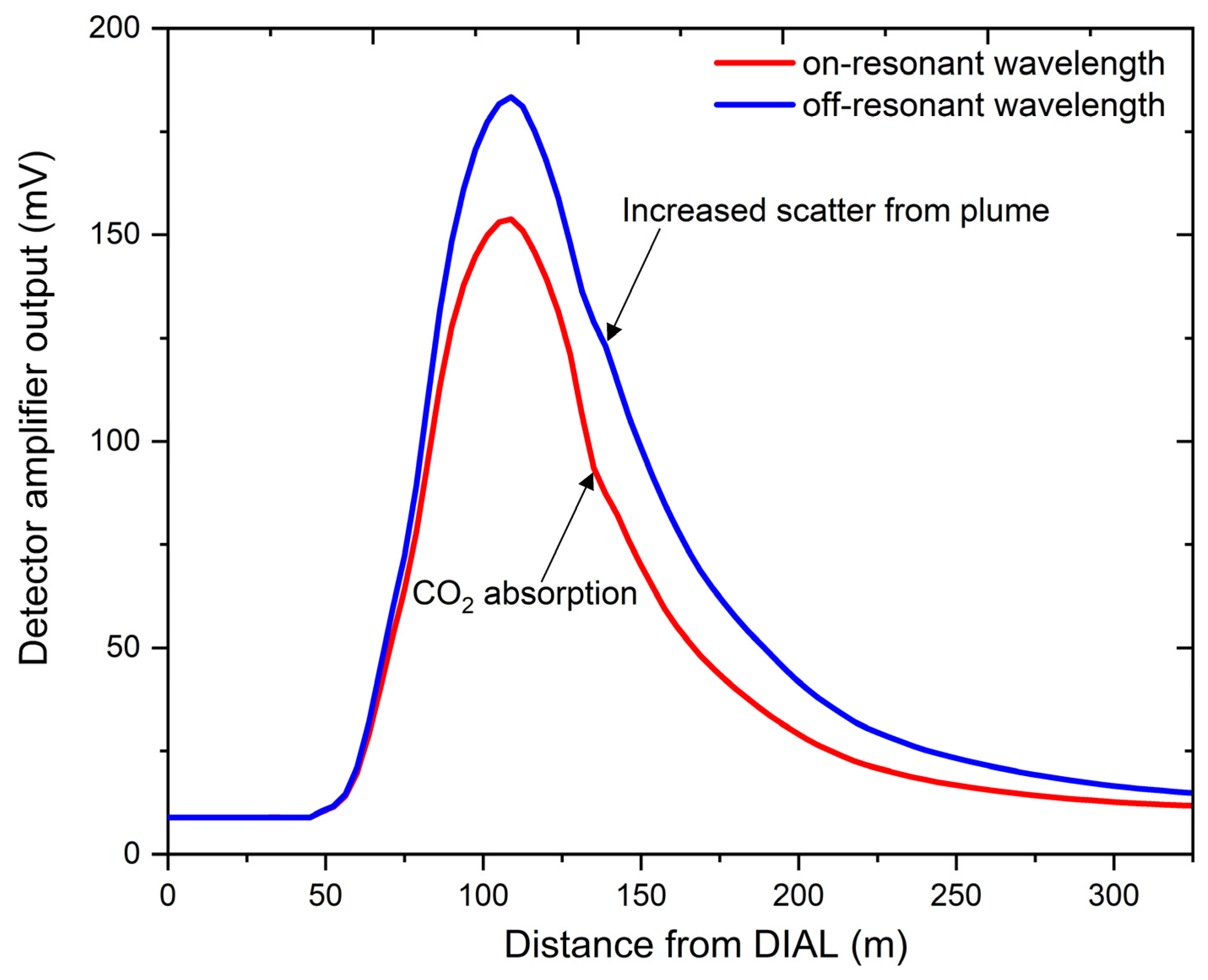
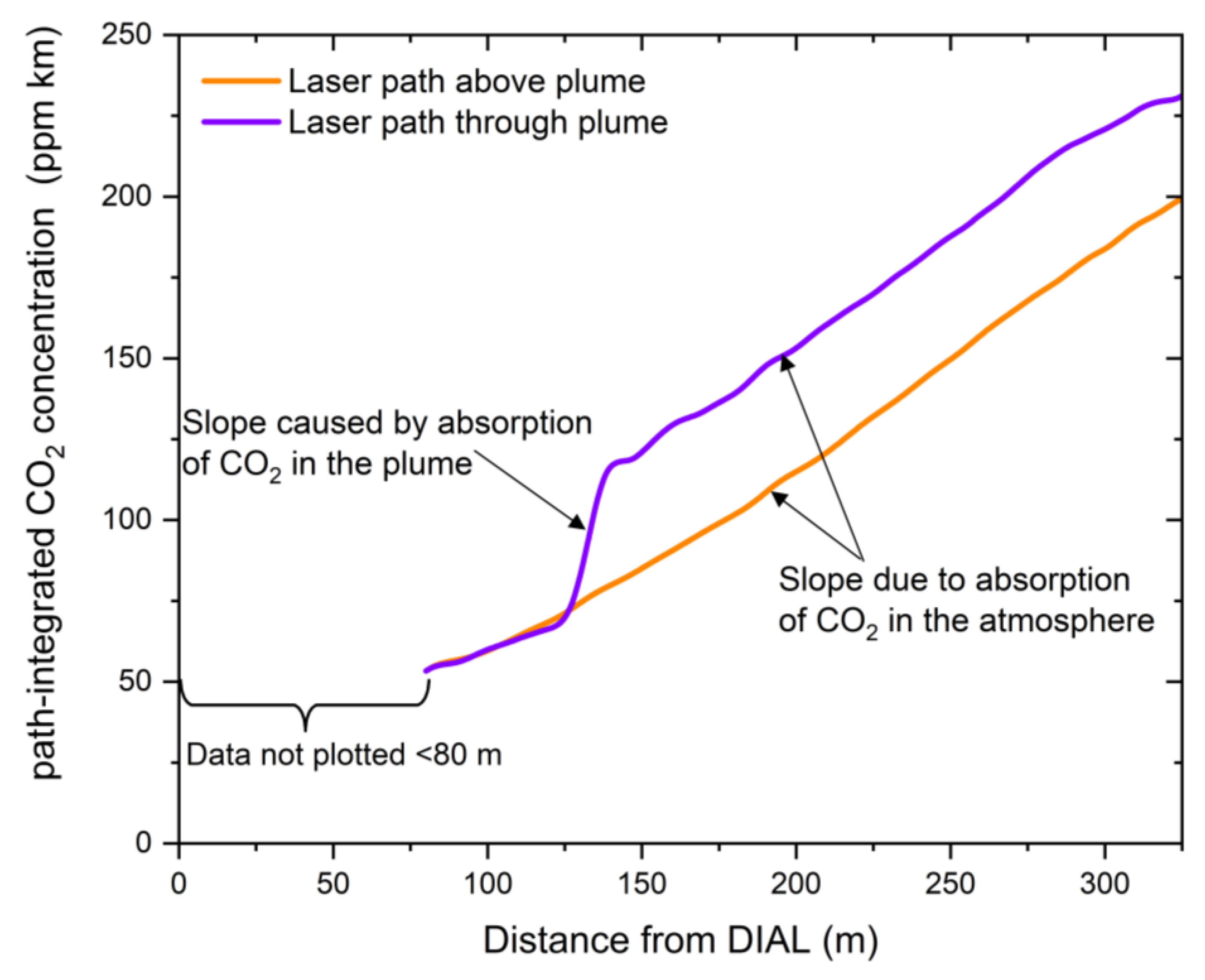
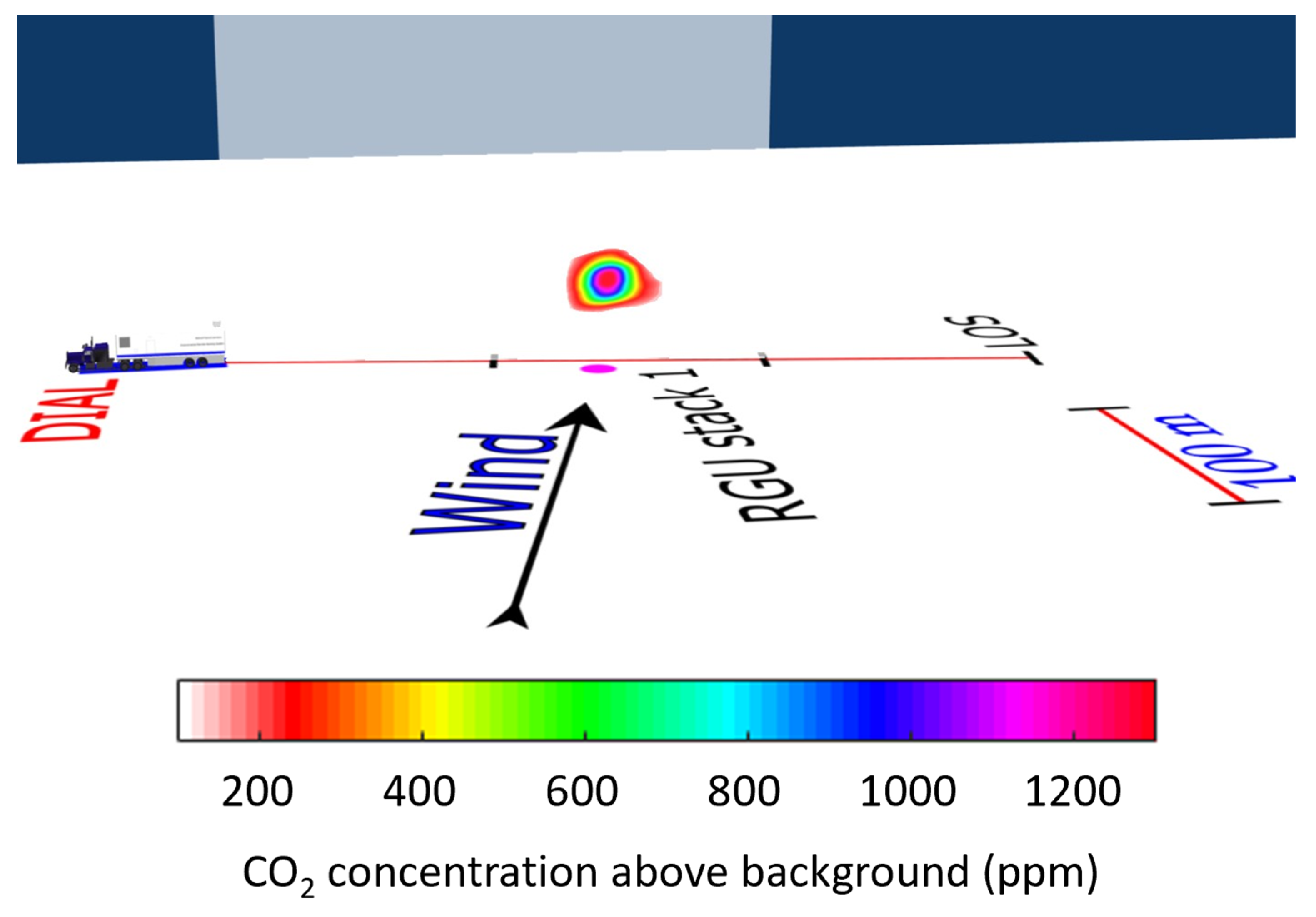
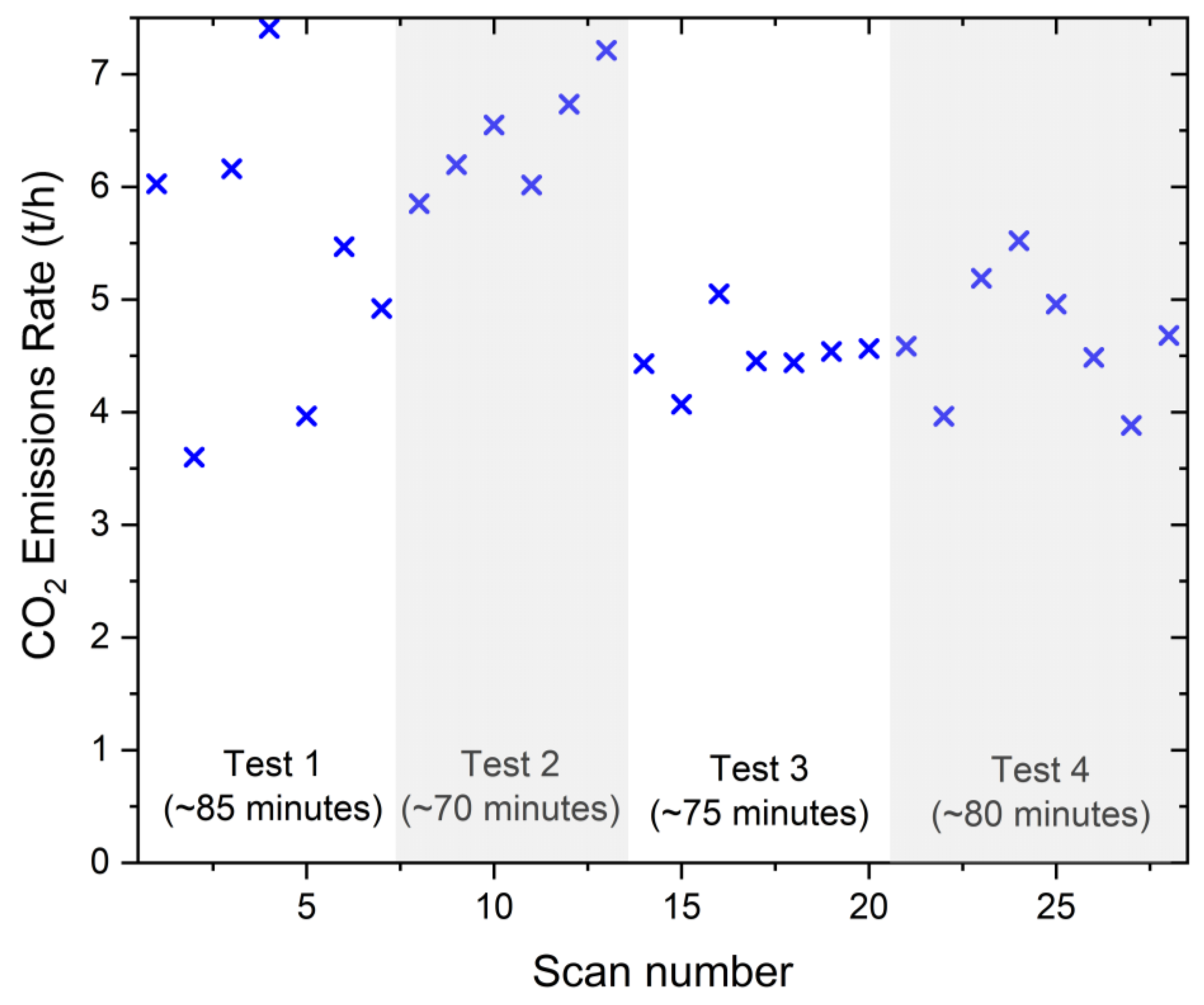
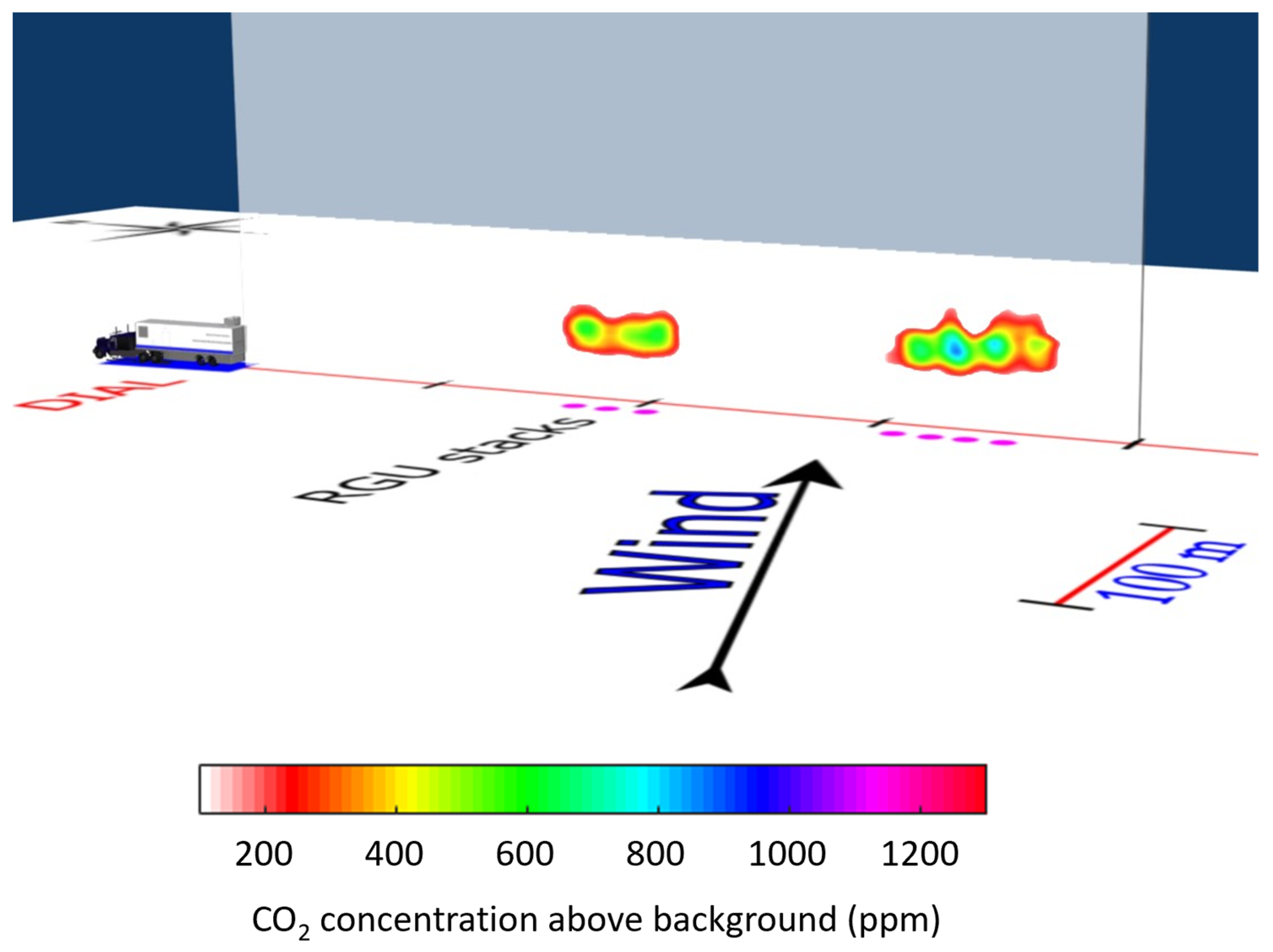



| Parameter | Value | Units |
|---|---|---|
| Pulse length | 9 | ns |
| Repetition rate | 10 | Hz |
| 1064 nm Nd:YAG energy | 650 | mJ |
| 532 nm Nd:YAG energy | mJ | |
| 718 nm energy before DFM | 50 | mJ |
| 1064 nm energy before DFM | 60 | mJ |
| 2.2 µm energy before OPA | 2–5 | mJ |
| 1064 nm energy before OPA | 200 | mJ |
| 2.05 µm output energy | 15–20 | mJ |
| On wavelength | 2055.58 | nm |
| Off wavelength | 2055.24 | nm |
| Divergence | ~0.2 | mRad |
| Test | Number of DIAL Scans | DIAL | In-Stack | Calculated | Units |
|---|---|---|---|---|---|
| 1 | 7 | 5.36 ± 1.23 | 5.29 ± 0.66 | 5.50 | t/h |
| 2 | 6 | 6.43 ± 0.53 | 6.17 ± 0.88 | 6.21 | t/h |
| 3 | 7 | 4.51 ± 0.27 | 4.30 ± 0.78 | 4.29 | t/h |
| 4 | 8 | 4.66 ± 0.47 | 4.58 ± 0.79 | 4.64 | t/h |
Disclaimer/Publisher’s Note: The statements, opinions and data contained in all publications are solely those of the individual author(s) and contributor(s) and not of MDPI and/or the editor(s). MDPI and/or the editor(s) disclaim responsibility for any injury to people or property resulting from any ideas, methods, instructions or products referred to in the content. |
© 2023 by the authors. Licensee MDPI, Basel, Switzerland. This article is an open access article distributed under the terms and conditions of the Creative Commons Attribution (CC BY) license (https://creativecommons.org/licenses/by/4.0/).
Share and Cite
Howes, N.; Innocenti, F.; Finlayson, A.; Dimopoulos, C.; Robinson, R.; Gardiner, T. Remote Measurements of Industrial CO2 Emissions Using a Ground-Based Differential Absorption Lidar in the 2 µm Wavelength Region. Remote Sens. 2023, 15, 5403. https://doi.org/10.3390/rs15225403
Howes N, Innocenti F, Finlayson A, Dimopoulos C, Robinson R, Gardiner T. Remote Measurements of Industrial CO2 Emissions Using a Ground-Based Differential Absorption Lidar in the 2 µm Wavelength Region. Remote Sensing. 2023; 15(22):5403. https://doi.org/10.3390/rs15225403
Chicago/Turabian StyleHowes, Neil, Fabrizio Innocenti, Andrew Finlayson, Chris Dimopoulos, Rod Robinson, and Tom Gardiner. 2023. "Remote Measurements of Industrial CO2 Emissions Using a Ground-Based Differential Absorption Lidar in the 2 µm Wavelength Region" Remote Sensing 15, no. 22: 5403. https://doi.org/10.3390/rs15225403
APA StyleHowes, N., Innocenti, F., Finlayson, A., Dimopoulos, C., Robinson, R., & Gardiner, T. (2023). Remote Measurements of Industrial CO2 Emissions Using a Ground-Based Differential Absorption Lidar in the 2 µm Wavelength Region. Remote Sensing, 15(22), 5403. https://doi.org/10.3390/rs15225403






